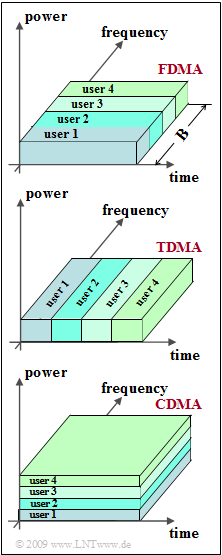Difference between revisions of "Aufgaben:Exercise 5.1: FDMA, TDMA and CDMA"
| Line 3: | Line 3: | ||
}} | }} | ||
| − | [[File:EN_Mod_A_5_1.png|right|frame|FDMA, TDMA and CDMA | + | [[File:EN_Mod_A_5_1.png|right|frame|FDMA, TDMA and CDMA]] |
The diagram illustrates the principle of | The diagram illustrates the principle of | ||
| − | + | # Frequency Division Multiple Access $\rm (FDMA)$, | |
| − | + | # Time Division Multiple Access $\rm (TDMA)$, | |
| − | + | # Code Division Multiple Access $\rm (CDMA)$. | |
| − | In the | + | In the "multiple access methods" listed here, it is assumed that there are several transmitter-receiver pairs that independently divide up a transmission medium. |
| − | + | "Multiplexing", on the other hand, is when a multiplexer $\rm (MUX)$ bundles several signals at the beginning of a transmission path and a demultiplexer $\rm (DEMUX)$ splits the common signal again at the end. | |
| + | The following abbreviations are used for this purpose: | ||
| + | # Frequency Division Multiplexing $\rm (FDM)$, | ||
| + | # Time Division Multiplexing $\rm (TDM)$, | ||
| + | # Code Division Multiplexing $\rm (CDM)$. | ||
| + | This exercise asks which of these methods (FDMA/FDM, TDMA/TDM, CDMA/CDM) are used by some of the communication systems (DSL,GSM, UMTS) that are still important today. | ||
| Line 21: | Line 26: | ||
| − | + | Notes: | |
*The exercise belongs to the chapter [[Modulation_Methods/Aufgaben_und_Klassifizierung|Tasks and Classification]]. | *The exercise belongs to the chapter [[Modulation_Methods/Aufgaben_und_Klassifizierung|Tasks and Classification]]. | ||
Revision as of 17:26, 27 November 2021
The diagram illustrates the principle of
- Frequency Division Multiple Access $\rm (FDMA)$,
- Time Division Multiple Access $\rm (TDMA)$,
- Code Division Multiple Access $\rm (CDMA)$.
In the "multiple access methods" listed here, it is assumed that there are several transmitter-receiver pairs that independently divide up a transmission medium.
"Multiplexing", on the other hand, is when a multiplexer $\rm (MUX)$ bundles several signals at the beginning of a transmission path and a demultiplexer $\rm (DEMUX)$ splits the common signal again at the end.
The following abbreviations are used for this purpose:
- Frequency Division Multiplexing $\rm (FDM)$,
- Time Division Multiplexing $\rm (TDM)$,
- Code Division Multiplexing $\rm (CDM)$.
This exercise asks which of these methods (FDMA/FDM, TDMA/TDM, CDMA/CDM) are used by some of the communication systems (DSL,GSM, UMTS) that are still important today.
Notes:
- The exercise belongs to the chapter Tasks and Classification.
- Information on the communications systems under consideration can be found under the following links:
- (1) Digital Subscriber Line $\rm (DSL)$,
- (2) Global System for Mobile Communications $\rm (GSM)$,
- (3) Universal Mobile Communications Systems $\rm (UMTS)$.
Questions
Solution
- FDMA, TDMA and CDMA are multiple access methods or multiplexing techniques, which are then abbreviated to FDM, TDM and CDM:
Frequency (Time, Code) Division Multiplexing. - These terms have nothing to do with modulation and equalization.
(2) Solutions 2 and 3 are correct:
- FDMA is also used in analog systems, of which classical broadcasting (since the 1930s) is an example.
(3) Solutions 1 and 2 are correct:
- GSM uses FDMA and TDMA.
- In the so-called D band (uplink: 890 – 915 MHz, downlink: 935 – 960 MHz), there are 124 FDMA channels of 200 kHz each at the upper and lower ends of the range in each direction, taking into account the guard bands of 100 kHz each.
- In the E band (uplink: 1710 – 1785 MHz, downlink: 1805 – 1880 MHz), 374 FDMA channels can be used.
- With time division multiplexing (TDMA) an additional eight subscribers can be supplied in each frequency band.
- A TDMA frame has a length of 4.62 ms, so that time slots of 0.577 ms duration are available for each subscriber in this time interval.
(4) Solutions 1 and 3 are correct:
- The UMTS variant "UMTS Terrestrial Radio Access–Frequency Division Duplex" (UTRA–FDD) used in Germany consists of twelve paired uplink and downlink frequency bands, each with a bandwidth of 5 MHz, between 1920 MHz and 1980 MHz (uplink) and between 2110 MHz and 2170 MHz (downlink).
- Thus, there is always an FDMA component. CDMA is also used in each of the 5 MHz bands, so that up to 512 subscribers can be active simultaneously in each frequency band.
(5) Solution 1 is correct:
- Nowadays, DSL (Digital Subscriber Line) is usually used for fast Internet connections.
- This is based on OFDM (Orthogonal Frequency Division Multiplexing), which is an FDM variant.
- However, the individual spectra are not separated, but rather overlap.
- Due to the orthogonality, however, there is no mutual interference.
